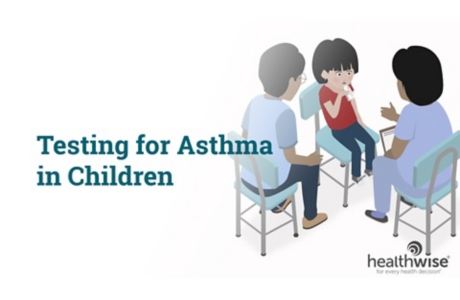How Asthma Develops in Children
Overview
Asthma is the most common long-lasting (chronic) disease of childhood. It usually develops before age 5.footnote 1 Many children who have allergies get asthma, but not all. And not every child with asthma has allergies.
In most cases of persistent asthma, the first symptoms (such as wheezing) start in the first years of life. One study notes that about 25 out of 100 children with persistent asthma began wheezing before 6 months of age and about 75 out of 100 began wheezing by 3 years of age.footnote 2
Early infection with respiratory syncytial virus (RSV) that causes a lower respiratory infection is a risk factor for wheezing.footnote 2 But other research shows that upper respiratory infections that do not progress to lower respiratory infections may protect a child from developing asthma.footnote 2
If your child has persistent asthma, he or she may have:
- Developed symptoms before age 3.
- Had allergies in infancy and childhood.
- A family history of allergies.
- Wheezing when there is no viral infection.
- Recurrent asthma attacks associated with viral infections.
- Wheezing severe enough to require a hospital stay.
Asthma as your child grows
It is likely that your child will not develop asthma even if he or she wheezes as an infant.
- About 15 out of 100 infants who wheeze develop persistent wheezing and asthma.footnote 2
- About 60 out of 100 infants who wheeze no longer wheeze by age 6.footnote 2
- About 50 out of 100 preschool-age children who wheeze have persistent asthma later in childhood.footnote 3
It is also hard to predict whether your child's asthma will continue into the teen years or adulthood.
- In most cases of intermittent asthma associated with respiratory infections (rather than allergies), symptoms tend to become less severe and may go away by the teen years.
- Asthma seems to continue into the teen years in children who have moderate to severe asthma. If your child has moderate to severe asthma, he or she may have asthma as an adult.footnote 1
Related Information
References
Citations
- Covar RA, et al. (2014). Allergic disorders. In WW Hay Jr et al., eds., Current Diagnosis and Treatment: Pediatrics, 22nd ed., pp. 1171–1206.
- Guilbert T, Krawiec M (2003). Natural history of asthma. Pediatric Clinics of North America, 50(3): 524–538.
- Wood RA (2002). Pediatric asthma. JAMA, 288(6): 745–747.
Credits
Current as of: August 6, 2023
Author: Healthwise Staff
Clinical Review Board
All Healthwise education is reviewed by a team that includes physicians, nurses, advanced practitioners, registered dieticians, and other healthcare professionals.
Current as of: August 6, 2023
Author: Healthwise Staff
Clinical Review Board
All Healthwise education is reviewed by a team that includes physicians, nurses, advanced practitioners, registered dieticians, and other healthcare professionals.



